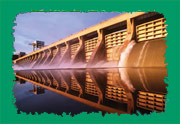Renewable EnergySustainability-SMART! Home
Hydropower
Traditional hydropower changes a body of water so that the water’s flow can be used to generate electricity. For example, a dam may be built on a river to trap the water so it can be released through a turbine to generate electricity. Or, water can be pumped from a lower reservoir to a higher reservoir, and stored there. When it is needed, it flows down through a turbine for electricity generation. Most traditional hydropower facilities are found in hilly or mountainous areas.
New hydropower uses energy from the natural movement of water to produce electricity without changing the water flow. For example, the constant flow of water in a river can spin the blades of underwater turbines to produce electricity.
Hydropower is the largest renewable energy source for electricity generation in this country. It accounts for about 6% of total U.S. electricity generation, and 46% of electricity generation from all renewables. |




